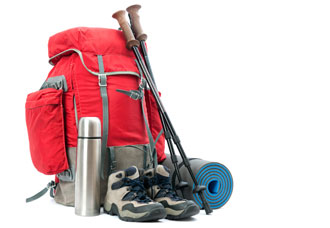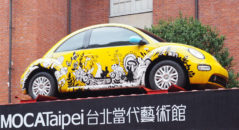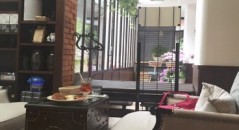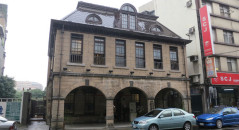
Note: The Urban Hiker contributed this article to Taiwan Ho! in 2003. While some things may have changed (please see endnotes), Elephant Mountain remains a wonderful urban hiking destination a decade later.
Arguably, July is not the best time to engage in any outdoor activity, especially one that requires some amount of physical effort or exertion, which ultimately leads to perspiration and feelings of thirst, which usually necessitates the intake of fluids, thus more perspiration, ad nauseam, until your shirt and pants are soaked and you are quite a sorry, wet sight to behold. However, it being July as I have mentioned, even those folks who are blessed with slightly less active sweat glands than yourself, they are also feeling the heat. So have no fear, intrepid wanderer, as you get out there and enjoy the outdoors.
Fitted with new Mountainsmith Day Lumbar pack, I headed up Elephant Mountain this morning at about 9:00, which is the latest in good faith I can recommend anyone starting the hike. These mountain trails (up, down and around Sishou Shan, or Four Animal Mountain), located in Taipei’s Xin Yi and Nan Gang Districts, I was happy to find, are easily reached by public transport. My hardy companion and I met on Zhong Xiao East Rd. where we took the 299 bus west to the last stop, Yong Chun High School, and thus arrived. (Both the private San Chong and public Taipei City bus companies run along this route under same number–perhaps I am the only one who finds this a bit odd? Oh, no matter.) (1)
Upon getting off the bus, we continued up the hill, following the other brave souls who, like us, were intent on tackling Elephant Mountain this gloriously hot morning. Unlike another hike I have recently completed here in Taiwan (in Shiding, a short walk from the terminus of the 666 bus, but a long, long and at times arduous way up and over the mountains to Muzha and Makong), this one, in my opinion, is fine for the family and kids, and we even passed a group of folks getting their nice boxed lunches at the start, all that was missing was their tour group leader, complete with two bright orange signal flags and whistle. Thankfully. My hiking companion mentioned she had heard that there were two ways to start our ascent, but we opted for the entrance clearly marked “Elephant Mountain Path” instead of proceeding up the road to a Daoist temple, which did look interesting, carved into the side of the mountain as it was.
In the early stages of the hike, the path is paved nicely with flagstones, which offer secure purchase, and railings, which offer support and comfort to those who perhaps may struggle with the initial ascent. Along the route I was pleased to find a number of maps posted by the Taipei City government giving directions, distances, information about the local flora, etc. Unlike the signs atop Xian Ji Yan in Jingmei, with which I am quite familiar, these are all bilingual and colorful. The start of the ascent offers some spectacular vistas of Xin Yi District, including the massive Taipei 101 tower, now almost complete, looming over the rest of the skyline. (2)
Further to signs of man’s progress, there are some tunnels currently being bored into the mountain that I believe will eventually be part of the freeway linking Ilan and the east coast to downtown Taipei. (3) But thankfully, on this day, cars were not yet zipping through underneath us. The deeper meanings and significance of cutting a swath through this poor old elephant I would rather not consider. Albeit the #3 highway does run right through Maokong in a similar way, but you could argue that this cat was already empty, so no one objects. (4)
The way up took us past a number of interesting spots and lookout points, the most striking containing a large white statue of the Bodhisattva Guanyin, complemented with trellises and birds and greenery. Perhaps the heat and my semi-dehydrated state allowed for more contemplation than I am normally accustomed to, but I found this scene quite lovely and surreal, and despite being soaked, I felt at peace. Moving on up and up we reached the top of Elephant Mountain in a little under an hour, but decided against looking around as there was little protection from the sun. Instead, undaunted and unconquered, we continued along the path towards Mu Zhi Shan and further away Muzha. However, I knew we were in for it when not only the path became a bit less groomed, the signs also became somewhat more rustic and the distance indicators and fellow climbers all but disappeared. (Some friends had mentioned that there was more difficult terrain, at times requiring the use of ropes and ladders, and although we didn’t find it, I don’t doubt it was there somewhere.)
As Mu Zhi was a straight ascent, and the path to Muzha, at least for the moment, looked more gently rolling, we opted for the latter and continued carefully on, my companion teaching me some Taiwanese we could use to greet fellow wanderers we would meet along the way–a great thing, I think, especially when up in the mountains. It was around this point I spied the Muzha incinerator, painted with cute giraffe, not far from the City Zoo, and also not too far off from our current position. Curious, we questioned a group of folks enjoying some tea how long it might take to walk all the way to Muzha and were told anywhere from one to three hours. Indeed, walking in the mountains one usually takes a circuitous route to his or her destination, and looking at the direction our ridge was leading us, I reckoned it was close to two or three hours to Muzha, perhaps more. Next time.
We found a way down to bustling Wu Xing St. that first took us through the small attractive neighborhood of Zi Yun St. so I’m glad I had changed into the clean shirt I brought along with me. My companion insisted on walking home, despite my argument that walking in the mountains with a gentle breeze and buzzing cicadas was certainly preferable to hitting hot city pavement at 11:00 AM, especially so soon after our hike. Though I came to discover she knew something I didn’t, and that was that I was a mess, and I don’t blame the people on the 1 bus for avoiding me like they did. But what did I care?
So if you are considering doing this hike in summer, perhaps take note of the following: Buy fluids before boarding the bus as there are no shops around Yong Chun High School offering water, which you will need, unless you are descendant from camels or something. I, for one, am not, so I had to hike back down the road to the penultimate bus stop, buy fluids, and proceed back up. (5) Yawn. And although most of the hike is shaded, sunscreen is still advisable, especially for the fair-skinned among us.
Endnotes
(1) Since the article’s publication, the public Taipei bus company has been privatized and Metropolitan Transport has taken over the 299 line. The San Chung bus company continues to run buses under the same number.
(2) At 509m, Taipei 101 was the tallest skyscraper in the world from its opening in 2004 until the opening of the Burj Khalifa in 2010.
(3) These tunnels were indeed part of the Xinyi Expressway, which opened in 2005 and now links the Xinyi District with the #5 and #3 highways and southern Taipei’s Wenshan District.
(4) The name Maokong translates literally to “cat empty”. The original name comes from the Taiwanese and means “crease aperture” but the feline version in use today was adopted during the Japanese colonial period.
(5) According to Street View on Google Maps (accessed July 31, 2012) there are still no convenience stores in the area of the Yong Chun High School bus stop, so this advice remains sound.



